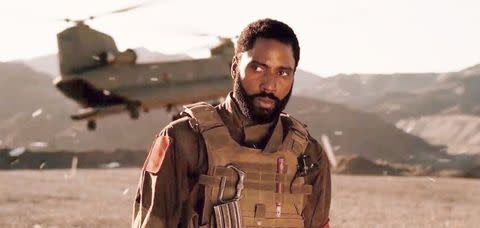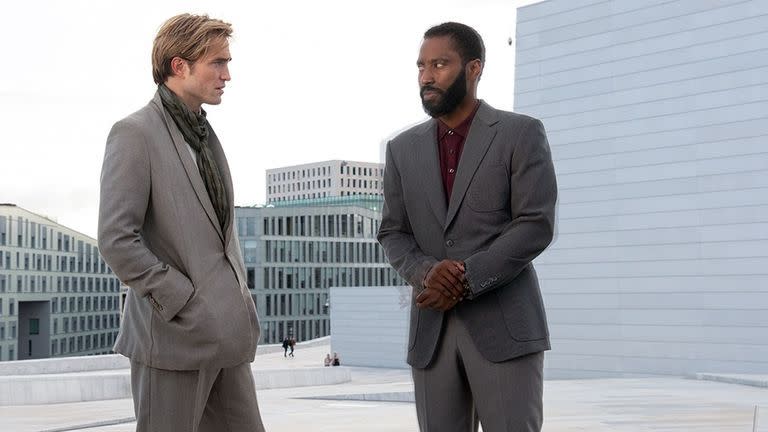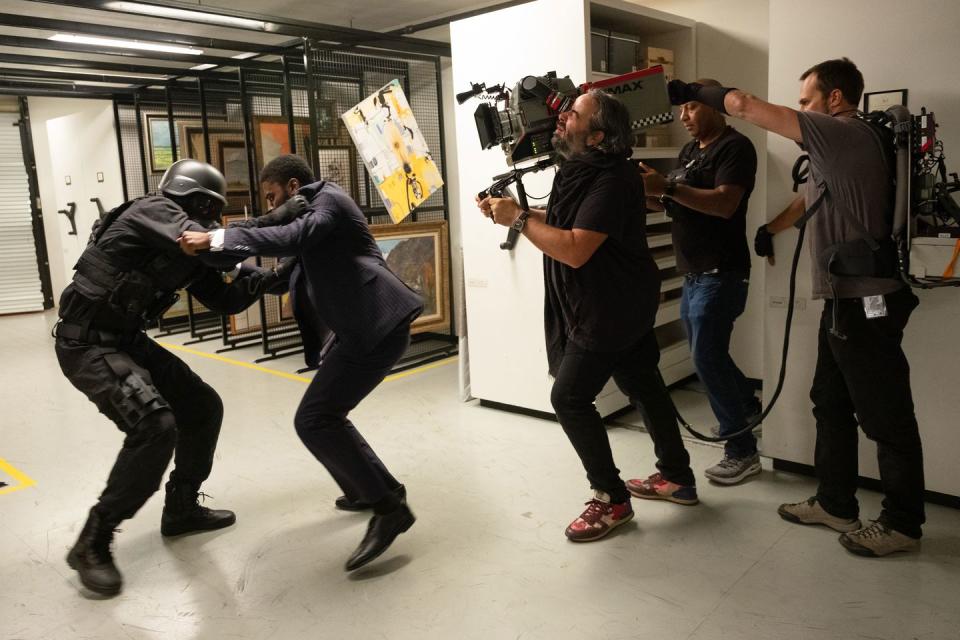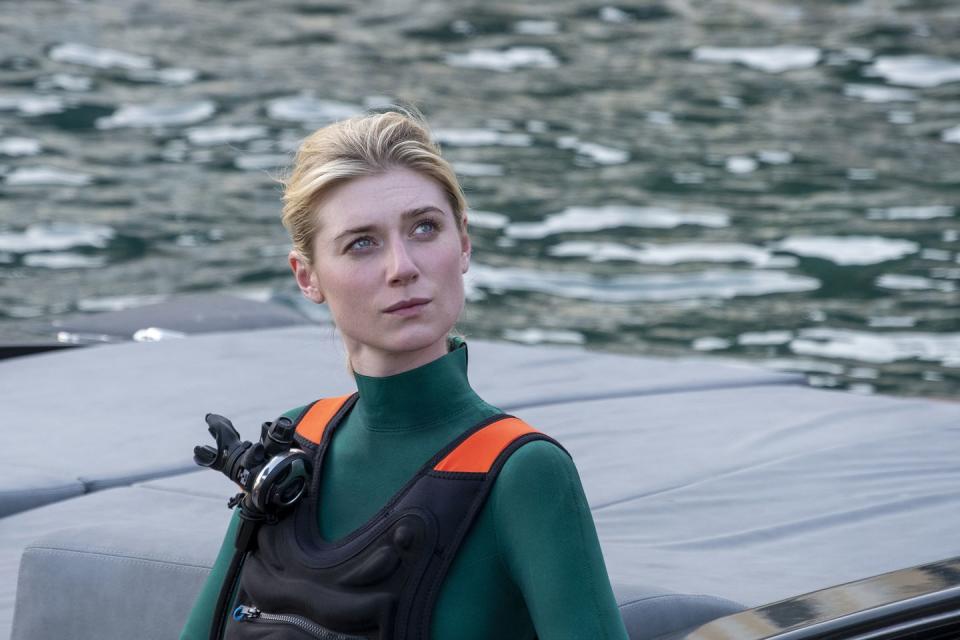The 'Tenet' Ending Explained, Plus all Your Questions Answered

This article contains spoilers for Tenet
"This whole operation is a temporal pincer."
So here we are, two hours into Tenet, receiving a briefing from Aaron Taylor-Johnson's military commander, Ives, which confuses things as much as it illuminates them. One thing's for sure, though: Christopher Nolan's brain-bender is drawing to a close. Or, wait – is it just beginning?
Tenet is a confusing cocktail of backwards car chases and theoretical physics in which it's often impossible to grasp any concept for more than a scene or two. By the time we reach its denouement, the audience is expected to keep track of doubled versions of every character, who are travelling in opposite directions through time. Alongside that, you need to know why Andrei Sator (Kenneth Branagh) is trying to reverse the arrow of time, what happens if he does, and why the Tenet algorithm is the key to the whole thing. Shall we unpack that together?

Let's start with that temporal pincer, a concept Ives mentions a few times. In your run-of-the-mill pincer movement, a force outflanks its opponent and attacks from two sides at the same time, stretching their defences. A temporal pincer, in the same way, involves troops attacking an enemy. However, they're reinforced by inverted versions of themselves, who are travelling backwards through time, and come armed with the knowledge of how the original attack went. This palindromic film is a temporal pincer, too. It takes the idea of a battle fought on two fronts and places us in the middle of a war between the past and the future.
Near the start of the film, the Protagonist meets Clémence Poésy's scientist, who informs him that at some point in the future, a technology is invented that can reverse the entropy of people and objects. What's entropy? It's the way any closed system will move from order to disorder – like how a fire will eventually burn out, or a boiled kettle will cool down as its energy disperses – and it underpins everything from human ageing to the collapse of stars. It is what gives time its arrow, meaning it can only flow in one direction. If you could, somehow, reverse entropy, then you wouldn't be travelling backwards in time, like a video being rewound. You would reverse what we perceive as the flow of time, like recording over what came before with a new version of the past (but which is now the future).
Confused? Well, the physics doesn't matter too much. All you need to know is that Sator's plan is to use the algorithm to reverse the arrow of time permanently, which means that rather than simply flowing backwards, the people in the future would be able to overwrite the past. Everyone in our version of time would cease to exist. The universe probably would, too.

Which brings us to our concluding firefight, in which the forces of the present (the good guys) have been split into two teams, blue and red. The red soldiers are travelling forward through time; their blue counterparts start their attack ten minutes in the future, but are travelling backwards through time.
The red and blue lights are a clear way of us differentiating between the time periods, as we also see in the two rooms between the turnstile, where the present version of Sator is in the red container with The Protagonist, while the past version in the blue container with a gun held to Kat's head.
This could well be a Nolan nod to Maxwell's Demon thought experiment, which we see drawn on a whiteboard in the background of a scene where The Protagonist practises catching bullets. In simple(ish) terms, it's a thought experiment in which a demon controls a door between two closed systems, allowing fast particles into one side, and trapping slow particles in the other. Eventually, one side heats up, the other slows down, and the laws of entropy are broken. In the diagrams of the thought experiment we see red and blue particles entering another system, like the red and blue of the future and the past altering each other when a daemon opens a door (or perhaps a turnstile) between the two.

During the temporal pincer movement battle of the film, Neil goes back through the turnstile in order to help the red team, before inverting himself again to help out the blue team and keep moving forward through time to finish this loop of his story. It is in this battle scene, in which both teams are working against clocks – one counting down from ten and the other counting up to it – that the true meaning of the name of the film becomes clear.
Tenet (a title that refers to ten minutes forward and ten minutes backwards, as per the pivotal battle at its climax) ends with a scene that closes the loop of the film, as Neil (Robert Pattinson) reveals that it was The Protagonist (John David Washington) who recruited him in the future. Which clears up why Neil was always one step ahead and knew what was coming. Also why he knew that The Protagonist never drinks on the job.
This is clarified as Neil walks away, when we see an orange string on his rucksack. This is the same detail that appeared on the bag of the man who saved The Protagonist from an inverted bullet during the opening Opera siege in Kiev, and later, during the temporal pincer movement, on the man who unlocks the gate to the bomb. As Neil explains, this is the end of the story for him – he has to go back into the inverted side of the battle, so that he can open the gate and step in front of the bullet meant for The Protagonist. Neil's loop is closed, but for The Protagonist, this is the beginning of their story together.

How, you ask, rubbing your temples raw in confusion, does that work?
Well, as The Protagonist explains in the epilogue, when sat in the passenger seat behind Priya, he was the one who started the Tenet organisation in the first place. He inverted himself some time in the future, set up the whole mission, then went on to recruit Neil and arm him with the information he needed to help. He also, it would appear recruited himself, setting up the mission which he would recruit his past self into without knowing that the version of him the future is the one pulling all of the strings.
The reason he pays a visit to Priya is because she is "tying up loose ends" and trying to get rid of Kat because she knows about Tenet. Kat speaks her location into the phone which The Protagonist gave her and he is able to invert himself to this point and save her as he knows where to find her. We walk away knowing that the chain of events haven't been altered by what we have watched, as "what's happened, happened", but instead that in the future the world was always safe because they had already gone into the past to make it so.

There are theories that suggest that this is an ending which sets Tenet up for a sequel, with the future after the ending in which The Protagonist sets up Tenet and recruits Neil amounting to at least a film's worth of content. Given Nolan's fondness for standalone stories and creating whole new worlds to immerse us in, and given his insistence this is an original story not one tied to another film he's made, it feels likely this is the last we'll see from the Tenet-verse. Nolan has showed us all of the aspects of the story he feels make it complete, what's left to wonder about are the shadowy moments which he prefers to leave as unanswered questions to which we can fill in the blanks.
This means that it leaves scenes and characters for us to piece together, such as the theory of whether Neil is in fact Kat's son who grew up and was recruited by him in the future. It seems that these theories are destined to be unanswered questions rather than pieces of gold in the rubble which Nolan left there to mine in the future. Infuriating as that might be, the sense that some things are up in the air is an enjoyable contrast to the plot which ends in a largely predictable and tied-up manner.

Nolan's form of time inversion has raised the question of whether there are parallel universes which exists within the film with the different version of each character representing a different universe, or whether each version of, say, Kat and The Protagonist exist in the same universe.
The theory that there are different universes would mean that the turnstiles serve as a bridge or wormhole between these worlds, one where time flows normally and another where it flows in reverse. This could have been inspired by a news story from years ago which suggested there could be a parallel universe in which time moves backward. The alternative is that all of these events happen within the same universe, but that the different versions of each character, which pass through time in opposing directions, are on loops which once closed keep circling on repeat.

The film's ending is a neat way to wrap up the story and close the circle, but the physics and interlocking timelines in the film are so complicated that the film needs a loop-closing denouement to knot together all those loose threads. After all the bombast of the preceding 150 minutes, it's a conclusion that's less of a bang and more of a satisfying sigh, as you finally catch your breath. After you do catch your breath, the temptation is to try and work out where the story begins and where it ends, as we've been watching the plot unfold in weird loops and wrong directions. Tenet is intentionally playing with our understanding of time and evading being able to be digested in a way that we can easily compute.
Nolan films tend to end on a note of sentimentality, like the powerful image of Tom Hardy setting his plane alight in the closing moments of Dunkirk, while also leaning into the ambiguous in terms of science, like the head-scratching conclusion of Interstellar.

Nolan has always resisted giving the final say on what his films definitively mean, wanting instead for audience's to make their own mind up. However, a commencement speech to Princeton University in 2015, he did give his two cents on the ambiguous spinning top which closed out Inception, saying: "The way the end of that film worked, Leonardo DiCaprio’s character Cobb – he was off with his kids, he was in his own subjective reality. He didn’t really care anymore, and that makes a statement: perhaps, all levels of reality are valid."
As an ending, Tenet's is less ambiguous than Inception's close yet it still leaves some room for the audience to piece theories together themselves. It doesn't quite throw all of the pieces up in the air and ask us to guess, instead it feels a puzzle piece has been placed which allows us to see the full picture. In this way, it more closely resembles the ending of Memento – which is really the middle of the narrative.
For Nolan, who doesn't like to tell stories in a linear way, an ending is never quite a full stop, but more a trailing ellipsis.
Like this article? Sign up to our newsletter to get more articles like this delivered straight to your inbox
Need some positivity right now? Subscribe to Esquire now for a hit of style, fitness, culture and advice from the experts
You Might Also Like

